
The Nickelodeon(s)

Here you can find out
some more details about SAILOR's various Nickelodeons and see
some pictures of the instruments - from Georg's original creation
to the Steinway-Nickelodeon and all the other successors.
The band new 'Mark 7' Nickelodeon was first used in August 2010.
You can see it at the bottom of this page.
Click here for the different Nickelodeons or scroll down...
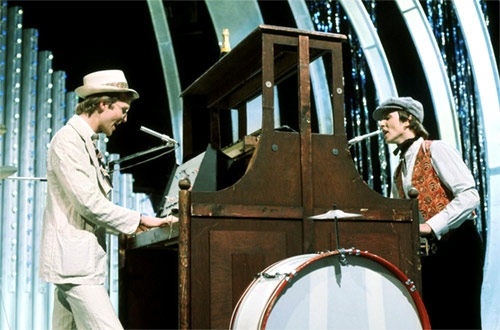

The
Nickelodeon story
(taken from the official SAILOR biography):
By the time the first SAILOR album
was finished the complexity of the group sound created a new
challenge for SAILOR: How were four musicians going to
successfully deliver the sound of about ten instruments on stage
without increasing their line-up? (Bear in mind that this was
1974, long before the advent of computer keyboards which can play
any sound at the touch of a button.)
Within a very short time, in fact possibly as little as a month
after the final mix of the SAILOR album, Georg had come up with
the solution: a custom-designed all-purpose machine, the
constituents of which were two upright pianos, two synthesizers,
mini organs and glockenspiels all mechanically linked and
contained within a wooden frame also designed by Georg.
Construction work took place above a pub, appropriately in one of
the seedier parts of London.
Henry: "I remember standing next to Georg handing him
hammers, nails, glue, sandwiches and anything else required, as
he set about his creation like a man possessed! After the final
staining of the wood which made it resemble some strange piece of
antique furniture, I recall standing back, looking at it and
thinking: 'He actually expects us to play the bloody
thing?'"
The basic keyboards were back to back, enabling Phil and Henry to
face each other when playing, and also to talk to each other when
bored. Phil played what was referred to as the bass side, Henry
the treble side, and so the Nickelodeon was born.
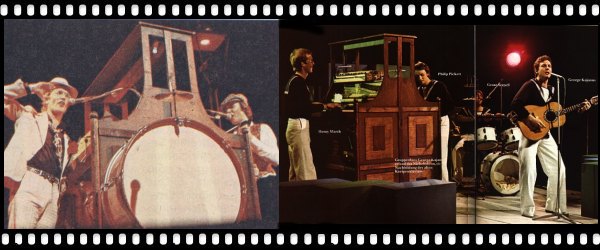
The
Nickelodeon
(taken from the official "The Third Step"
tour programme 1976):
"Finally a few
words about the £ 7000 dream-machine which bears a passing
resemblance to duplicate honky-tonk pianos removed from any Dodge
City saloon during Gold Rush era and placed back to back on
stage.
The instrument is basically Georg's brain-child and is in fact
the casing of two upright pianos moulded together to look like an
old-fashioned barrel-organ and raised on a rostrum so that it can
be played standing up.
Georg rigged up some piano keys to a Piano Mate, two synthesisers
and a glockenspiel device was adapted from a series of doorbell
mechanism which instead of activating a clapper to hit a bell now
sets of little hammers against glockenspiel bars.
There is a DC current activated by that part of the piano action
which is like hammer, so you can play glockenspiel and piano
together or either separately. Other synthesisers fitted
underneath provide bass pattern from a keyboard and there are one
or two secret modifications which they are keeping secret.
The device which is quite unique and their own patent is now
insured for an undisclosed sum and almost priceless."
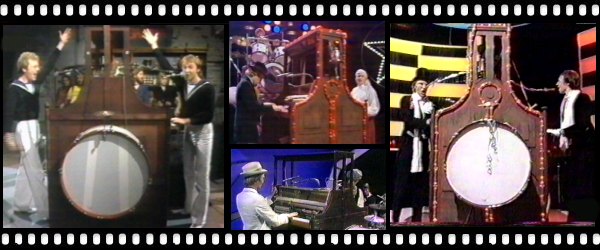
In some 70s TV shows fake Nickelodeons were used instead of the original one. This was because some people thought it would be much easier to place a fake Nickelodeon on the stage than to get the original one for only one or two songs for TV shows (e.g. Musikladen, Starparade). So, some funny fake Nickelodeons appeared from time to time throughout the 70s...
After SAILOR“s reunion in the 90s a new Nickelodeon had to be created. The new blue Nickelodeon was at first only needed for TV performances, so that the keyboards on Phil“s and Henry“s side were placed on it in order to perform with playback.

|
When SAILOR were finally able to perform live again it was necessary to create a new Nickelodeon for live concerts. The construction of the black Nickelodeon happened in 1993. The black
"GK" Nickelodeon had a red lightchain and a
bell. Georg about the black Nickelodeon: "... The next one was the black one - the sort of Steinway-version of the Nickelodeon - which cost a huge amount of money. I think it was very beautiful, and of course it collapsed, but it still weighed a ton, and it was a monster - a serious piece of kit, as they would say. It was a very substantial piece of equipment, but hey - it was a substantial part of SAILOR! That's something I completely designed and had built, I didn't build it myself, but I had people build it. But I designed all the details on it, which took a lot of time. I thought it looked very nice, I was very pleased with that one." |
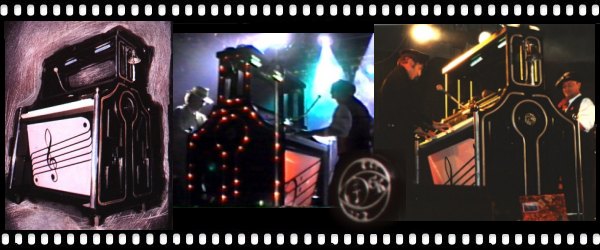
|
|
In the meantime the remainings of this Nickelodeon were moved to the webmaster's garden: |
|
|
|
...And later to the webmaster's brother's garage:

In 1996 another Nickelodeon had to be built because the black Nickelodeon's keyboard on Henry's side had been "injured" during a performance in late 1995, and there were also other difficulties, e.g. because the red lightchain was broken.
That“s why SAILOR decided to build a new Nickelodeon. The result was a Nickelodeon which was made out of plastic. It contained many small plastic parts and a metal frame, so that it could quickly be built before SAILOR“s performances without taking up too much space during the transport. Inside the metal frame there was also room for a fog machine and some special lights.
Sometimes the fog machine inside
this Nickelodeon produced too much fog, so that it looked as if
the whole instrument was on fire. During a SAILOR performance in
a German TV show in 1997 the fog even came out of the keyboards:
Because of this Phil said: "It“s still hot from us playing
it", and Henry“s comment upon this was: "Looks like
dinner“s ready." ;-)

And now... the 2001 version:
This Nickelodeon was first used at the show in Wolfsburg
(Germany) on 03 November 2001. It was created by SAILOR's sound
engineer and tour manager Graham Naylor. Graham has been involved
in designing the last two Nickelodeons, the black one (see above)
and the new blue one. The idea of the black one was a frame that
could be taken apart, with the moulded panels that were shaped
like the old Nickelodeon. This packed into flightcases which
meant it could travel more easily - but it was heavy because of
the cases! So, in 2001, Graham suggested building a new
Nickelodeon that was its own flightcase. The guys agreed and
Graham designed and built the new Nickelodeon, with help from
Rob:
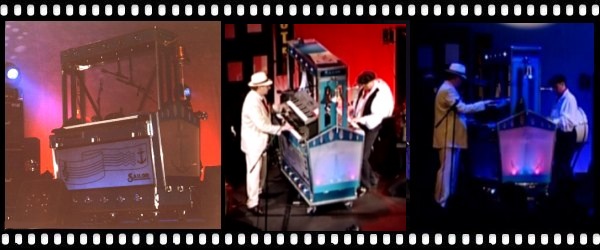

|
|
During the last years there were
two Nickelodeons that were being used by SAILOR for their shows -
the black plastic-version created in 1996 (see above) and the
blue version created in 2001 (see above).
In 2004 Rob Alderton designes another version, as Phil Pickett
explained in his Holland Tour Diary: "Rob has been designing
a wonderful new "frock" for the keyboards on certain
shows where the "Nick" might be too cumbersome, or
expensive for certain promoters. It's beautifully elaborate and
intricate in design and we're sure, if asked nicely he might
eventually post it on Marinero some time in the future."
Unfortunately it was only used at two concerts in Rostock and
Reutlingen (Germany) in December 2004, when the new Nickelodeon
("Nickerbox" ;-)) was only half finished. The design
was completed but unfortunately never used again...
And here's Rob's original design of the "Nickerbox" side-pannels:
|
|
One pf the newer versions: A cardboard copy of a Nickelodeon...
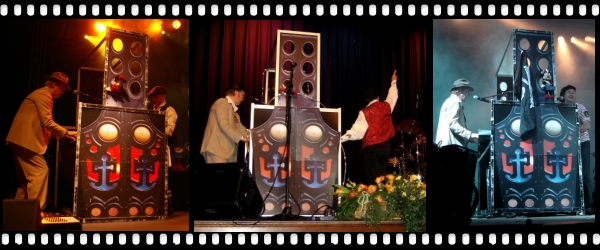
The brand
new Nickelodeon, Mark 7
by Phil
Pickett
And now... some photos: |
|
|
|
|

First concert with the new
Nickelodeon - August 2010